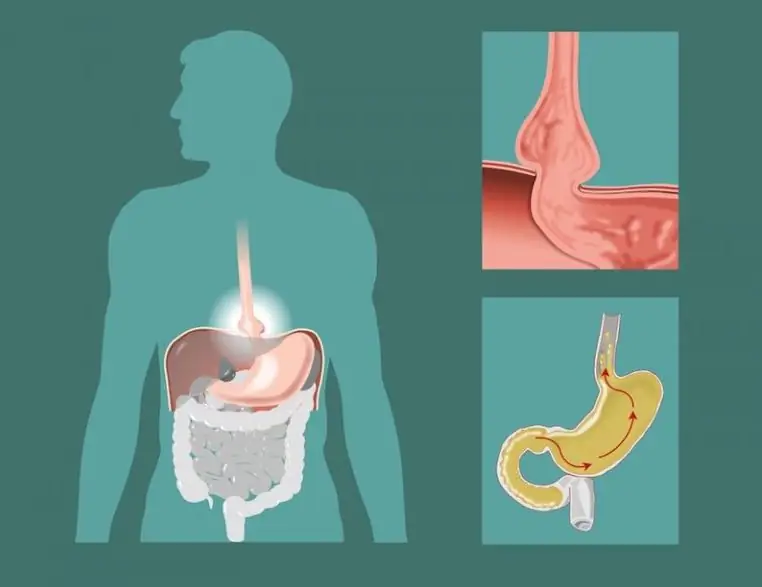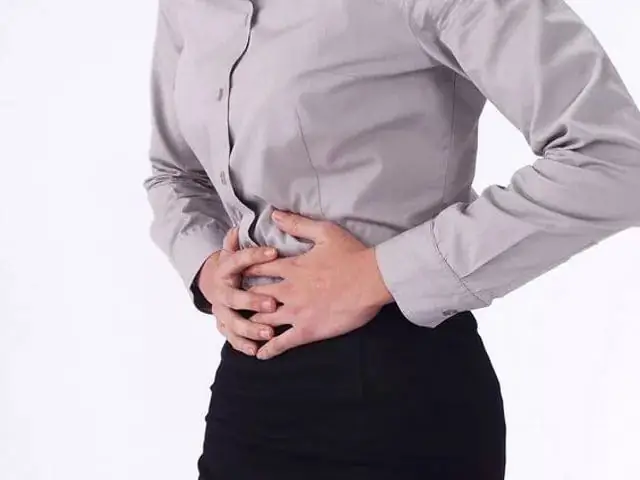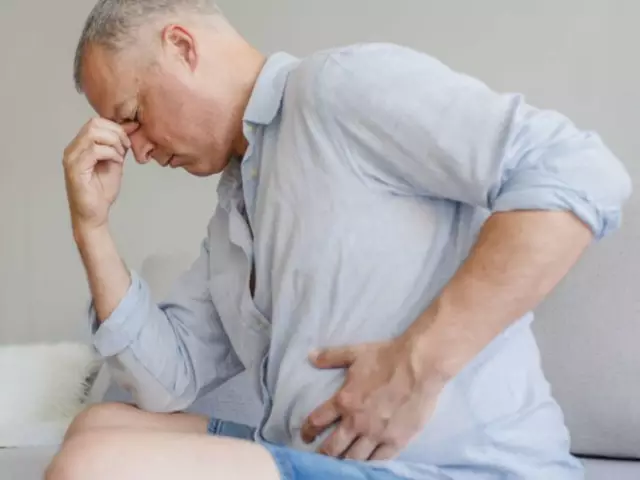- Author Curtis Blomfield [email protected].
- Public 2023-12-16 20:44.
- Last modified 2025-01-23 17:01.
The term "hernia of the esophagus" refers to a disease of a chronic nature, characterized by the displacement of some of the internal organs from the abdominal cavity into the chest through the dilated opening of the diaphragm. According to statistics, 22% of the population of the Russian Federation suffer from the disease, while it is most often diagnosed in people with pathologies of the gastrointestinal tract. Timely seeking qualified medical help will help to avoid negative consequences and surgical intervention.
General information
The esophagus is a muscular tube, hollow inside. It connects the pharynx and stomach. Its length is 23.5-25 cm. The esophagus is necessary so that the swallowed food can enter the stomach.
The muscular tube has two valves (sphincters). Thanks to their work, food moves only in one direction. Even if a person stands for a long timehead, food will not go back down the throat.
The esophagus passes from the chest cavity into the abdominal cavity through a hole in the diaphragm. This is a kind of partition, consisting of muscle tissue and tendons. The main task of the diaphragm is the implementation of the respiratory process. It also separates the thoracic and abdominal cavities. Under the influence of various adverse factors, there is a violation in the work of the diaphragm. In this case, the stomach shifts upward, and part of the muscular tube can move in its opening along with the gastric contents. In this case, a hernia of the esophagus is diagnosed.

Causes of disease development
In most cases, pathology occurs against the background of age-related changes. There is a weakening of the muscles and ligaments, their elasticity is lost and they begin to function worse.
In addition, the following factors may be the causes of a hernia of the esophagus:
- genetic predisposition;
- frequent episodes of flatulence;
- bearing period;
- complicated childbirth;
- abnormal accumulation of fluid in the abdominal cavity;
- diseases of the respiratory system, accompanied by a prolonged cough;
- high intensity exercise;
- vomit;
- congenital pathology of the stomach or esophagus;
- obesity;
- chronic constipation;
- constant overeating;
- pathology of the digestive system;
- scarring due to burns (thermal or chemical);
- injuries (both open and closed);
- uncontrolled intake of certain medications;
- smoking;
- excessive coffee consumption.

Classification
Depending on the mechanism of development and anatomical features, a hernia of the esophagus can be:
- Moving.
- Paraesophageal.
- Mixed.
Sliding hernia of the esophagus is currently the most commonly diagnosed. It is characterized by the penetration into the chest cavity of the cardia, a small part of the fundus of the stomach and the muscular tube. When a person changes the position of the body, the organs freely return to their normal position. But it also happens that they cannot cope on their own. In such situations, it is customary to speak of a pathology of a fixed nature.
A paraesophageal hernia is characterized by the fact that most of the stomach is in the chest cavity. In this case, the esophagus and lower sphincter remain motionless. Such a hernia is often pinched. This process is accompanied by the appearance of pronounced symptoms.
Mixed disease combines signs of both sliding and paraesophageal hernias. This ailment is usually classified depending on how much the internal organs have shifted from the abdominal cavity to the chest.
There are 3 degrees of mixed esophageal hernia:
- I. The stomach rises slightly and comes into contact with the diaphragm. The cardia remains in a normal position. In the chest cavitythe lower part of the esophagus is located.
- II. Both the stomach and the cardia fit snugly against the diaphragm. The thoracic cavity still contains only the lower portion of the muscular tube.
- III. The esophagus, cardia and most of the stomach are significantly displaced. Loops of the small intestine often also enter the chest cavity.
Based on which organs form hernias, they are divided into the following types:
- Sliders. They can be esophageal, cardiofundal, or gastric.
- Paraesophageal. They are divided into fundic and antral.
At the same time, each of them has a different severity of signs.
Symptoms
A hernia of the esophagus at the initial stage of development may not manifest itself in any way. As it grows, a person begins to feel the first warning signs.
The main symptoms of a hernia of the esophagus are the following conditions:
- Heartburn. It can be of different intensity. Most often, heartburn occurs after a meal and when the patient takes a horizontal position.
- Pain. Their character can be cutting, blunt, burning or stabbing. Most often, pain occurs behind the sternum, less often in the epigastric region or hypochondrium. When a hernia is infringed, it is sharp.
- Dysphagia. This condition is characterized by difficulty in passing food through the muscular tube into the stomach. Patients report a feeling of discomfort associated with food getting stuck in the esophagus.
- Burp. Its predecessor is a feeling of fullness in the upper abdomen.
- Hoarse voicepain in the tongue. These conditions occur due to the reflux of gastric juice into the oral cavity, which causes a peptic burn.
- Hiccup. It is long lasting.
- Incessant cough.
- Suffocation.
- Heart rate failure.
Patient rarely shows all symptoms at once. The set of signs also depends on the type of pathology.

Diagnosis
Information on what to do with a hernia of the esophagus should be provided by a doctor. When the first alarming symptoms appear, you should consult a gastroenterologist.
During the initial appointment, the doctor interviews the patient. The specialist must provide information about all the symptoms. Based on the results of the survey, the doctor issues a referral for examination.
It is carried out using the following instrumental diagnostic methods:
- FGDS. The essence of the method is the introduction of a flexible tube into the esophagus and stomach through the oral cavity. The duration of the procedure, as a rule, does not exceed 5 minutes.
- X-ray examination. The patient is placed on a horizontal surface, after which the doctor takes a picture. After that, a person needs to take a barium suspension. Then the specialist again takes a series of pictures, with the help of which it is possible to assess the nature of the movement of the substance.
- Daily pH-metry. An electrode is placed on the patient's skin, and a probe is inserted into the nasal passage. After that, they are connected to a block that registers the acidity index.stomach and esophagus. His patient wears on a belt during the day.
Based on the results of the diagnosis, the doctor draws up the most effective treatment regimen for esophageal hernia. The operation is extremely rare. As a rule, surgical intervention is indicated when medical therapy is ineffective and in advanced cases.
Medicated treatment
The goal of therapy is to relieve symptoms and prevent complications.
As a rule, the doctor prescribes the following drugs:
- heartburn relief;
- eliminating pain;
- reducing the degree of gastric secretion;
- reducing acidity;
- mucosal protection.
Currently, the pharmaceutical market has many types of drugs with a similar effect. Each of them has contraindications, and therefore only a doctor can prescribe certain drugs, taking into account the individual characteristics of the he alth of each patient.

Diet
Diet plays an important role in the disease, as in most cases it is accompanied by episodes of gastroesophageal reflux.
It is necessary to exclude from the menu for hernia of the esophagus:
- Products that increase acidity. These include: fatty, smoked, s alty, fried, spicy dishes; coffee; Black tea; citrus; bakery products; confectionery.
- Foods to increasegas formation: legumes, cabbage, radish, mushrooms, cereals, grapes, milk, pears.
- Any kind of herbs and spices.
- Soda drinks.
- Alcohol.
With regular dieting, the patient's condition improves significantly.
Therapeutic exercise
Gymnastics is essential in the fight against disease. The purpose of its implementation is to get rid of unpleasant symptoms and strengthen the musculoskeletal system.
Complex of exercises:
- Lie on your side, raise your head and hold it with your hand. On a deep breath, stick out your stomach, on the exhale - relax.
- Kneel down. While inhaling, slowly bend forward, while exhaling, you need to return to the starting position.
- Lie on your back. Maintaining a normal breathing rhythm, turn the body to the right, then to the left.
- Take a standing position, stretch your arms along the body, your back should be even. Slowly turn the torso to the left and right, but so that the lower body remains motionless.
- Kneel down with your palms on the floor. Sliding your hands on the floor, slowly lower yourself down.
Each exercise must be performed 5 times. Contraindications to gymnastics are pronounced heartburn and pain in the sternum.

Surgical treatment
Surgical intervention is indicated in case of failure of conservative therapy, as well as in the presence of a large hernia.
Currently it is done using one of the followingmethods:
- Laparoscopy. The hernia of the esophagus is removed after lowering the upper part of the stomach back into the abdominal cavity. After that, the opening of the diaphragm is sutured. The operation is less traumatic. In addition, after its implementation, the patient quickly returns to normal life.
- Belsi's way. Access to the hernia is provided through an incision made to the left of the sternum. During the operation, the doctor fixes the lower part of the esophagus to the diaphragm, and sutures the fundus of the stomach to its front wall.
- Gastrocardiopexy. An incision is made in the middle of the abdomen just above the navel. During the operation, the upper part of the stomach and esophagus is sutured to a subdiaphragmatic structure, such as the preaortic fascia.
- Allison's method. Its essence is to suture the legs of the diaphragm. It is currently rarely used.
Surgical intervention is contraindicated during pregnancy and in severe cases of other existing pathologies.

Unconventional methods
National treatment of a hernia of the esophagus does not exclude the need to see a doctor. With its help, it is possible to alleviate the general condition, weakening the degree of symptoms.
Most Effective Recipes:
- Make chamomile tea. Drink it after every meal in small sips.
- Prepare 1 tsp. carrot seeds and pour 200 ml of boiling water over them. Cool and take the infusion in the morning after meals.
- Take 1 tbsp. l. flax seeds and pour them 3 tbsp. l. cold water. Let it brew 8-10h. After the specified time, heat the resulting mass and eat it, carefully chewing the seeds.
With severe heartburn, you can add 1 tsp to a glass of water. soda and drink it. But this method should be resorted to extremely rarely. It is also contraindicated for pregnant women.
Consequences
And now about the dangers of a hernia of the esophagus. In the absence of timely treatment, at best, it leads to inflammation of the mucous membrane and pinching of the muscular tube or stomach. A hernia is also accompanied by the development of reflux esophagitis, which often causes malignant pathologies.

Advice to patients
A person diagnosed with an ailment must regularly follow the following rules:
- do not overeat;
- sleep on a high pillow;
- prevent constipation;
- find time for physical therapy every day;
- reduce body weight with obesity;
- follow a sparing diet.
Following these recommendations in most cases avoids surgery.
In closing
Hernia of the esophagus is a disease characterized by displacement of some of the internal organs from the abdominal cavity to the chest. Its development is accompanied by severe pain, heartburn, belching, discomfort when swallowing food. When the first alarming symptoms occur, you should contact a gastroenterologist. The doctor will prescribe an examination andresults will result in the most effective treatment regimen.






